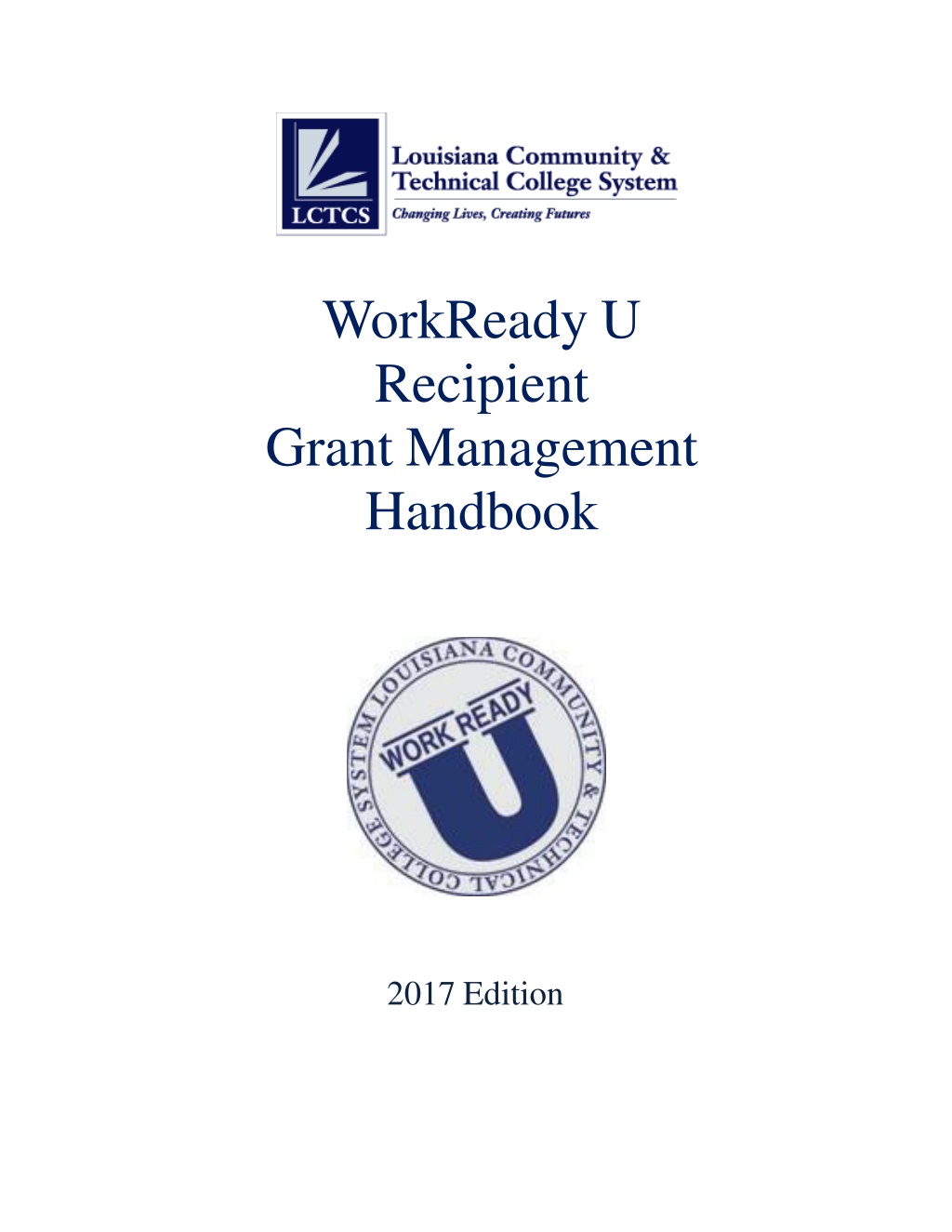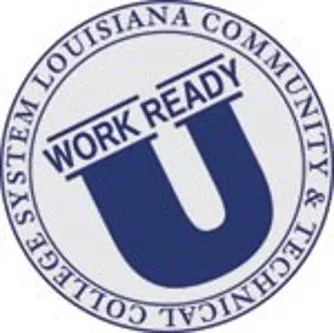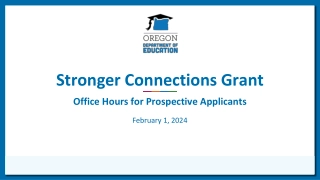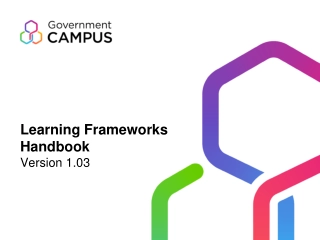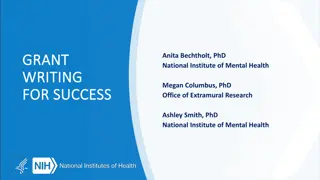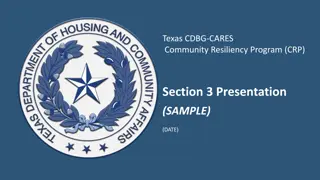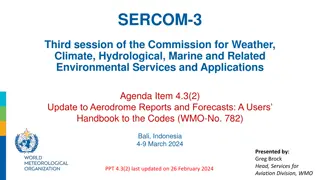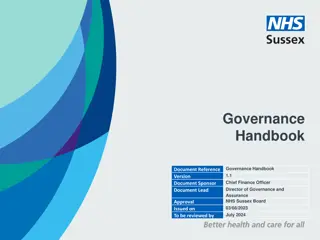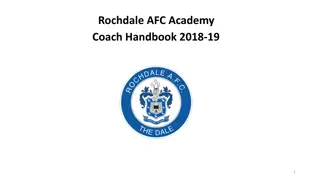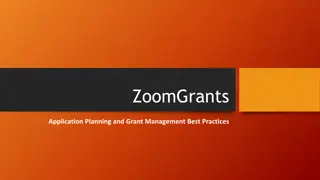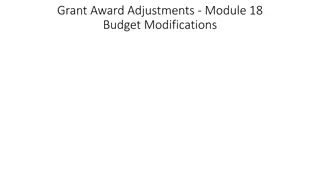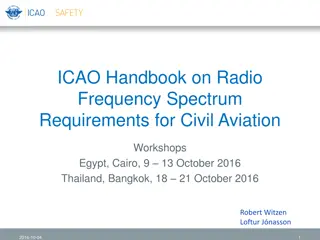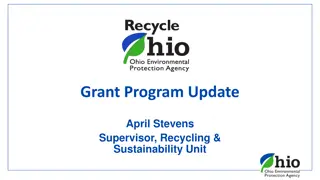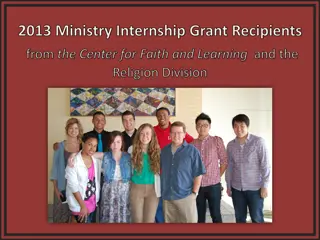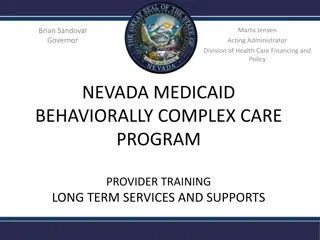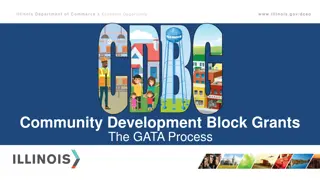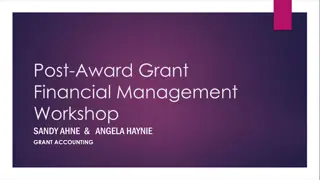Grant Management Handbook for WorkReady U Recipients
This handbook provides detailed guidelines and procedures for managing grants awarded to recipients of WorkReady U. It covers topics such as fiscal policies, maintenance of effort, allowable costs, program income, procurement, and property management.
Download Presentation

Please find below an Image/Link to download the presentation.
The content on the website is provided AS IS for your information and personal use only. It may not be sold, licensed, or shared on other websites without obtaining consent from the author.If you encounter any issues during the download, it is possible that the publisher has removed the file from their server.
You are allowed to download the files provided on this website for personal or commercial use, subject to the condition that they are used lawfully. All files are the property of their respective owners.
The content on the website is provided AS IS for your information and personal use only. It may not be sold, licensed, or shared on other websites without obtaining consent from the author.
E N D
Presentation Transcript
Pag e 1 of 50 WorkReady U Recipient Grant Management Handbook 2017 Edition
TABLE OFCONTENTS Pag e 2 of 50 Contents LIST OF ACRONYMS........................................................................................................................................................4 1.0 PURPOSE OF MANUAL .......................................................................................................................................5 2.0 ABOUT LCTCS AND WORKREADY U..............................................................................................................6 2.1 WorkReady U Organizational Structure and Functions.......................................................................................6 2.2 WorkReady U Grants ..........................................................................................................................................6 2.3 Local Grant Applications.....................................................................................................................................8 3.0 FISCAL POLICIES AND PROCEDURES...........................................................................................................12 3.1 Grant Award Notifications (GAN) ....................................................................................................................12 3.2 General Budget Information ..............................................................................................................................13 3.3 WRU Recipients Budget ..................................................................................................................................13 3.4 Classification of Budget Expenditures...............................................................................................................15 3.5 LCTCS eGrants System.....................................................................................................................................18 4.0 MAINTENANCE OF EFFORT (MOE)................................................................................................................19 5.0 PROGRAM INCOME...........................................................................................................................................20 6.0 ALLOWABLE COSTS .........................................................................................................................................22 Basic Cost Principles...........................................................................................................................................22 Selected Items of Cost .........................................................................................................................................23 Allowable Under AEFLA....................................................................................................................................23 Allowable under State Policy..............................................................................................................................23 Supplement not Supplant .....................................................................................................................................23 7.0 TIMELY OBLIGATION OF FUNDS ..................................................................................................................25 7.1 Period of Performance Federal Funds.............................................................................................................25 Carryover Procedure............................................................................................................................................25 7.2 Period of Performance State Funds.................................................................................................................25 7.3 Obligations.........................................................................................................................................................25 8.0 PROCUREMENT .................................................................................................................................................27 9.0 PROPERTY MANAGEMENT.............................................................................................................................28 9.1 Property Classifications.....................................................................................................................................28 9.2 Inventory Procedure...........................................................................................................................................28 9.3 Lost or StolenItems...........................................................................................................................................29 9.4 Use of Equipment ..............................................................................................................................................29 9.5 Disposal of Equipment and Non-Consumable Supplies ....................................................................................30 9.6 Disposal of Consumable Supplies .....................................................................................................................30 10.0 RECORD KEEPING ...........................................................................................................................................31
Pag e 3 of 50 11.0 TIME AND EFFORT CERTIFICATIONS.........................................................................................................32 12.0 CAREER AND TRAINING SERVICES REPORTING REQUIREMENTS .....................................................34 13.0 ACCOUNTABILITY REQUIREMENTS..........................................................................................................36 14.0 MONITORING ...................................................................................................................................................38 15.0 FREQUENTLY ASKED QUESTIONS (FAQs).................................................................................................40 16.0 CALENDAR AT A GLANCE ............................................................................................................................42 FORMS .......................................................................................................................................................................43 Program Income Certification Form(s) Maintenance of Effort (MOE) Form(s) Electronic Transfer Form (ETF)
Pag e 4 of 50 LIST OFACRONYMS AEFLA: Adult Education and Family LiteracyAct MOE: Maintenance of Effort CPO: Chief Procurement Officer NRS: National Reporting System DOA: OIG: Louisiana Division of Administration United States Department of Education s Office of the Inspector General EDGAR: OMB: Education Department General Administrative Regulations Office of Management and Budget EFT: Electronic Funds Transfer OCTAE: United States Department of Education s Office of Career, Technical and Adult Education FAIN: RFP: Request for Proposal Federal Award Identification Number FMV: Fair Market Value RRC: Regional Resource Centers FSR: Financial Status Report SIS: Student Information System GAAP: USDE: Generally Accepted Accounting Principles United States Department of Education GAN: Grant Award Notification WIA: Workforce InvestmentAct HSE: High School Equivalency WIOA: Workforce Innovation and OpportunityAct LEA: Local Educational Agency WRU: WorkReady U LCTCS: Louisiana Communityand Technical College System
Pag e 5 of 50 1.0 PURPOSE OF MANUAL The primary purpose of the manual is to set forth the policies, procedures and guidelines intended to assist eligible recipients in the proper administration of adult education and literacy programs at the local level and ensure that all federal Adult Education Family Literacy Act (AEFLA) and state funds are lawfully expended. This manual provides programmatic information on how AEFLA and state funds are used at the local level once an eligible recipient s application is approved for funding. It includes information on the process used by the Louisiana Community and Technical College System (LCTCS) to review budget information; the process by which successful applicants request reimbursement; how to determine whether a cost is allowable; required fiscal and programmatic reports and their respective due dates; and the process used by WorkReady U (WRU) to monitor eligible recipients for compliance. The manual provides eligible recipients with a single point of reference for all post-award compliance requirements. Additionally, the Legislative Auditor of Louisiana and the U.S. Education Department s Office of Inspector General (OIG) and Office of Career, Technical and Adult Education (OCTAE) may rely on the procedures and internal controls described herein, in part, to assess LCTCS WRU s compliance with the AEFLA, the Education Department General Administrative Regulations (EDGAR), and the Uniform Administrative Requirements, Cost Principles and Audit Requirements for FederalAwards (2 C.F.R. Part 200 or Part 200). This manual was not designed, nor should it be construed as, a description of the policies and procedures of other programmatic divisions within LCTCS. It is an organic document which will be periodically updated to reflect significant changes at LCTCS and/or WRU.
Pag e 6 of 50 1. ABOUT LCTCS AND WORKREADY U This section of the manual provides background information on LCTCS WRU and the grants it administers. 1. WorkReady U Organizational Structure and Functions The LCTCS has a number of different offices. Not all of LCTCS offices have direct responsibilities for adult education grant administration and only those offices with such responsibilities will be discussed here. These offices include: (1) the WRU Grant Management Office; and (2) the Finance andAdministration Office. The WorkReady U Grant Management Office is primarily responsible for fiscal and programmatic aspects of the grant and manages the day-to-day grant functions of the AEFLA and adult education state grants. Particularly, responsible for the High School Equivalency data management system, as well as conducting the Request for Proposal (RFP) process; managing the local grant application process; approving allocations; issuing Grant Award Notifications (GANs) to recipients; reviewing local budgets and plans; monitoring programmatic compliance and providing technical assistance; establishing and overseeing the high school equivalencytesting program for the state; managing high school equivalency records; and processing and issuing high school equivalency credentials. The Finance and Administration Office is primarily responsible for the fiscal aspects of the grant and houses a number of sub-offices or divisions. These sub-offices/divisions include: Facilities, Finance, and Human Resources. The Finance and Administration Office is responsible for, among other things, overseeing the accounts payable and receivable functions at the state level as well as processing grant payments to eligible recipients (reimbursements), monitoring and managing the budget allocations for WRU at the state level, monitoring the procurement and inventory processes at the state level, and putting together the annual U.S. Department of Education (USDE) Financial Status Reports (FSRs) for WRU. 2. WorkReady U Grants Authorization and Funding for Adult Education in Louisiana Federal administration and funding is authorized under Title II Adult Education and Family Literacy (AEFLA) of the Workforce Innovation and Opportunity Act (WIOA) of 2014. State administration and funding of local adult education is authorized in Louisiana under L.R.S., 17:1871 and 17:3217. The WRU Grant Management Office administers federal and state supported grants. LCTCS acts as the pass-through agency for AEFLA grants. Funding to grant recipients is determined through a competitive grant application process. Continuation funding is contingent upon fund availability; local recipient s compliance with state and federal grant expectations including program quality, fiscal reporting, performance reporting expectations
Pag e 7 of 50 and/or grant assurances; and/or until WIOA is reauthorized. Grant recipients that do not meet these measures risk loss of funding at any point in the grant period. LCTCS will not use less than 82.5 percent of the federal grant funds to award grants under section 231. Grant recipients shall not expend more than five percent of federal adult education funding to administer the grant under Title II. In cases where five percent is too restrictive to allow for federal administrative activities, the recipient may negotiate with LCTCS to determine an adequate level of funds to be used for non-instructional purposes. LCTCS, WorkReady U (LCTCS/WRU) grant recipients are awarded funds to establish local adult education services that align with the goals of the WIOA State Plan for the State of Louisiana, and the LCTCS Adult Education System. Grant recipients are required to establish collaborations with partners who can assist in the delivery of quality comprehensive educational services and access to a comprehensive workforce development system for adult learners. Purpose The purpose of Adult Education in Louisiana under the Workforce Innovation & Opportunity Act (WIOA) is to enable local adult education providers, as core partners of Louisiana s workforce system, to develop, implement and improve adult education and literacy services throughout the state to further the vision and goals as outlined in the WIOA State Plan for the State of Louisiana, WIOA and LCTCS policies and procedures, in order to-- Assist adults to become literate and obtain the knowledge and skills needed for employment and economic self-sufficiency Assist adults who are parents or family members to obtain the education and skills needed to participate successfully in the educational development of their children and improve the economic opportunities of the family Assist adults in the attainment of a high school equivalency diploma and in the transition to postsecondary education and training through career pathways Assist immigrants and other individuals who are English language learners in improving their reading, writing, speaking and comprehension skills in English; improving their math skills; and acquiring an understanding of the American System of Government, individual freedom, and the responsibilities of citizenship Louisiana state law established adult education under the jurisdiction of the Louisiana Community and Technical College System (LCTCS), and LCTCS serves as the administrative entity for Title II, Adult Education (Louisiana Revised Statute 17:2317.1D, Acts 132 & 732 of the 2010 Regular Session) for the purpose of establishing and maintaining adult education programs to conduct adult education classes. Funding allocated to local providers for adult education must be approved by the System s President. WRU Grant Management Office is the unit within LCTCS responsible for the administration and oversight of Louisiana s statewide adult education system. Grant recipients were successful applicants of the one or more Title II program types and funding sources: A. Adult Education FEDERALGrants
Pag e 8 of 50 o WIOA Section 231 Adult Education and Literacy (ABE/ASE/ELA/Workplace Preparation/Workplace Literacy/Integrated Education & Training) o WIOA Section 243 English Language Acquisition/Integrated English Literacy and Civics Education (ELA/IELCE) o WIOA Section 225 - Corrections Education/Institutionalized Individuals (see WIOA Final Rules, Subpart F, 463.63 through 463.63) B. Adult Education STATE Grant WRU requires that the federal and state program awards adhere to the same authoritative regulations for AEFLA funds regarding allowable expenditures. Since the state is required to complete annual FSR reports and show that it matched all AEFLA funds spent on administration with nonfederal funds, WRU uses the state flow-through amount to recipients as part of the applicable match. Recipients shall not use federal and state funds for the administration of the high school equivalency (HSE) testing program. 2.3 Local Grant Applications Background Information On July 22, 2014, the Workforce Innovation & Opportunity Act of 2014 (WIOA) was signed into law to reauthorize the Workforce Investment Act of 1998 (WIA). WIOA requires the alignment of workforce, education and economic development systems to support access to high-quality, comprehensive and accessible workforce services for all individuals, including those with significant barriers to employment. Adult Education and Literacy (Title II) is identified as one of four required core partners in WIOA. The core partners are listed below: WIOARequired Core Partners: WIOA Title I- Adult, Dislocated Worker, and Youth Programs (LWC) WIOA Title II- Adult Education and Literacy Program (LCTCS) WIOA Title III- Wagner-Peyser Employment Service (LWC) WIOA Title IV- Vocational Rehabilitation Program (LWC/LRS) All four titles comprise the workforce system. In Louisiana, Titles I, III are under the administration of the Louisiana Workforce Commission (LWC). Title II is administered under the Louisiana Community and Technical College System (LCTCS). Title IV is under the administration of the Louisiana Workforce Commission, Louisiana Rehabilitation Services (LWC/LRS). Pursuant to WIOA Section 232, in order for an eligible applicant to be allocated AEFLA grant funds and/or state grant funds, the eligible applicant must submit an annual application which must be approved by LCTCS, WRU. The application shall describe how AEFLA and/or state grant funds will be used to provide mandated adult education activities with respect to state and local levels of performance and how the recipient will ensure compliance withAEFLA, WIOAand State requirements. Theapplication
Pag e 9 of 50 shallcontain such informationand assurancesas the LCTCS mayrequire, includingbut not limited to - (1)A description of how funds awarded under this title will be spent consistent with the requirements of title II ofAEFLA; (2)A description of any cooperative arrangements the eligible provider has with other agencies, institutions, or organizations for the delivery of adult education and literacy activities; (3)A description of how the eligible provider will provide services in alignment with the local workforce development plan, including how such provider will promote concurrent enrollment in programs and activities under title I, as appropriate; (4)A description of how the eligible provider will meet the State-adjusted levels of performance for the primary indicators of performance identified in the State s Unified or Combined State Plan, including how such provider will collect data to report on such performance indicators; (5)A description of how the eligible provider will fulfill, as appropriate, required one-stop partner responsibilities to-- Provide access through the one-stop delivery system to adult education and literacy activities; Use a portion of the funds made available under the Act to maintain the one-stop delivery system, including payment of the infrastructure costs for the one-stop centers, in accordance with the methods agreed upon by the Local Board and described in the memorandum of understanding or the determination of the Governor regarding State one-stop infrastructure funding; Enter into a local memorandum of understanding with the Local Board, relating to the operations of the one-stop system; Participate in the operation of the one-stop system consistent with the terms of the memorandum of understanding, and the requirements of the Act; and Provide representation to the State board. (6)A description of how the eligible provider will provide services in a manner that meets the needs of eligible individuals; (7)Information that addresses the 13 considerations listed in Title II, Sec. 231(e) and State mandates: The degree to which the eligible provider would be responsive to: Regional needs as identified in the local workforce development plan; and Serving individuals in the community who were identified in such plan as most in need of adult education and literacy activities, including individuals: Who have low levels of literacy skills; or Who are English language learners. The ability of the eligible provider to serve eligible individuals with disabilities, including eligible individuals with learning disabilities;
Pag e 10 of 50 The past effectiveness of the eligible provider in improving the literacy of eligible individuals, especially those individuals who have low levels of literacy, and the degree to which those improvements contribute to meeting the state adjusted levels of performance for the primary indicators of performance described in WIOA section 116; The extent to which the eligible provider demonstrates alignment between proposed activities and services and the strategy and goals of the local plan under section 108 of the Act, as well as the activities and services of the core partners; Whether the eligible provider s program: o Is of sufficient intensity and quality, and based on the most rigorous research available so that participants achieve substantial learning gains; and o Uses instructional practices that include the essential components of reading instruction; Whether the eligible provider s activities, including whether reading, writing, speaking, mathematics, and English language acquisition instruction delivered by the eligible provider, are based on the best practices derived from the most rigorous research available, including scientifically valid research and effective educational practice; Whether the eligible provider s activities effectively use technology, services and delivery systems, including distance education, in a manner sufficient to increase the amount and quality of learning and how such technology, services, and systems lead to improved performance; Whether the eligible provider s activities provide learning in context, including through integrated education and training, so that an individual acquires the skills needed to transition to and complete postsecondary education and training programs, obtain and advance in employment leading to economic self-sufficiency, and to exercise the rights and responsibilities of citizenship; Whether the eligible provider s activities are delivered by instructors, counselors, and administrators who meet any minimum qualifications established by the State, where applicable, and who have access to high-quality professional development, including through electronic means; Whether the eligible provider s activities coordinate with other available education, training, and social service resources in the community, such as establishing strong links with elementary schools and secondary schools, postsecondary educational institutions, institutions of higher education, LWDBs, One-Stop/American Job Centers, labor organizations, community-based organizations, nonprofit organizations, and intermediaries, in the development of career pathways; Whether the eligible provider s activities offer flexible schedules and coordination with federal, state, and local support services (such as child care, transportation, mental health
Pag e 11 of 50 services, and career planning) that are necessary to enable individuals, including individuals with disabilities or other special needs, to attend and complete programs; Whether the eligible provider maintains a high-quality information management system that has the capacity to report measurable participant outcomes (consistent with section 116) and to monitor program performance; and Whether the local area in which the eligible provider is located has a demonstrated need for additional English language acquisition programs and civics education programs. State Consideration: Staffing o All instructors hold, at a minimum, a post-secondary degree State Consideration: Class Scheduling o Adequate intensity and duration of instruction to allow participants to be progress-tested according the NRS/WorkReadyU Assessment Policy testing guidelines. o Class schedules/services, include classes that integrate face-to-face instruction with distance learning activities, to extend learning beyond the classroom and provide flexibility to meet the needs of the target population; o Commitment to provide year-round flexible scheduling with a minimum of 220 instructional days. o Correctional Education Programs must provide a minimum of 10 instructional hours per week.
Pag e 12 of 50 1. FISCAL POLICIES AND PROCEDURES Starting July 1, 2017, LCTCS and all recipients will use the state-approved eGrants system as the financial management and accounting system. LCTCS uses eGrants to track expenditures at the state level. Each recipient uses eGrants to track expenditures of their subgrant. At the beginning of a grant year, LCTCS s budget is loaded into eGrants and each grant and funding source is coded so that it can be easily tracked. At LCTCS, Finance Division staff are responsible for managing the budget and accounts payable at the state and local level. This section describes the budget and reimbursement process for WRU grants and the fiscal policies and procedures that successful applicants are expected to be aware of and adhere to. 1. Grant Award Notifications(GAN) The grant funds received by the local eligible program shall be expended for the purpose of the grant and in a manner consistent with fiscal requirements. Grant funds will be distributed utilizing a performance-based funding formula. After the subawards are determined, the allocations are provided to the Grant Accounting Program Manager, who loads the subrecipient award amounts into the eGrants system. Grant Award Notifications (GANs) are issued to successful grant applicants and budgets must be prepared for the GAN amount. Additionally, the award amount for each subrecipient is provided to the LCTCS Finance Division. The Director of Fiscal Affairs in the Finance Office is responsible for ensuring that non-federal expenditures are properly recorded, and tracks the state match. If the GAN is for a federal subgrant, the GAN will include the following: (1) subrecipient name; (2)subrecipient s unique identifier; (3) federal award identification number (FAIN), also known as the PR/Award number; (4) federal award date; (5) subaward period of performance state and end date; (6) amount of federal funds obligated by this action; (7) total amount of federal funds obligated to the subrecipient; (8) federal award project description; (9) name of federal awarding agency, pass-through entity, and contact information for awarding official; (10) CFDA number and name; and (11) indirect cost rate. Additionally, the GAN must also include: All requirements imposed by LCTCS, WRU, as the pass-through entity, on subrecipients to ensure that grant funds are used in compliance with federal statutes, regulations, and the terms and conditions of the federal award; Any additional requirements that LCTCS, WRU imposes on the subrecipient in order for LCTCS, WRU to meet its own responsibilities, including identification of any required financial and performance reports; An approved federally recognized indirect cost rate negotiated between the subrecipient and the federal government or, if no such rate exists, either a rate negotiated between LCTCS, WRU as the pass-through entity, and the subrecipient, or a de minimis indirect cost rate; A requirement that the subrecipient allow LCTCS, WRU and auditors to access the subrecipient s records and financial statements as necessary; and Appropriate terms and conditions regarding subaward closeout.
Pag e 13 of 50 2. General Budget Information Federal Awards [AEFLA] Recipients must classify all proposed expenditures within two types of service categories: 1. Instructional Costs - At least 95% of federal funds must be expended for adult education instructional activities. 2. Administrative Costs - Administrative costs may not exceed 5% of the total grant award. Under AEFLA section 233(a)(2), local administration activities can include accountability reporting, professional development, and activities geared toward alliance with the local plan and fulfilling one-stop partner responsibilities. Examples of allowable costs may include: Salaries of program administrators, supervisors; Non-instructional expenses; Clerical (personnel involved in clerical activities); Administrative fringe benefits as required for salaried positions; Administrativetravel to state meetings relatingto administeringadult education courses and educational activities; and Indirect Costs (if applicable). Note: The Federal Leadership funds awarded to recipients are intended to be used for capacity building activities to improve program performance. The Leadership GAN will specify the intended use of the designated funds. Although the budget must differentiate the Instructional and Administrative costs for the planned activities, if approved in writing by WRU, the administrative allowance may exceed the 5% cap. StateAwards Recipients must classify all proposed expenditures within two types of service categories: 1. Instructional Costs - At least 75% of state funds must be expended for adult education instructional activities. 2. Administrative Costs - Administrative costs may not exceed 25% of the total grant award. Local administration activities can include accountability reporting, professional development, and activities geared toward alliance with the local plan and fulfilling one- stop partner responsibilities. Examples of allowable costs may include: Salaries of program administrators, supervisors; Non-instructional expenses; Clerical (personnel involved in clerical activities); Administrative fringe benefits as required for salaried positions; and Administrativetravel to state meetings relatingto administeringadult education courses and educational activities. 3.3 WRU Recipients Budget LCTCS distributes funds based on a 100% reimbursement system, thus a recipient must first have an approved budget before obligating funds, then request funds prior to receiving any grant money. At LCTCS, the Finance Division oversees all payments made to recipients.
Pag e 14 of 50 Each recipient must designate two (2) authorized staff member(s) to become eGrants system users: Primary User and Secondary User. The primary user has the ability to enter budget information in the system AND submit financial information for approval to LCTCS. The secondary user only has the ability to enter and save budget information in the system. The eGrants users must be trained and tested on compliance with federal financial grant management requirements under EDGAR and AEFLA. The designated staff member(s) may receive training at the bi-annual EDGAR training hosted by LCTCS. After the training, the designated staff member(s) must pass a test demonstrating that the staff member(s) has a thorough understanding of the financial grant management requirements. When the staff member has passed the test, the staff member becomes a certified representative for the recipient. The certified representative is then responsible for reviewing each Request for Reimbursement for allowability and consistency with the approved budget. When the certified representative has reviewed the Request for Reimbursement for allowability and consistency with the approved budget and signed the request, the request is entered in the eGrants system. Once submitted the information is reviewed by the Grant Accounting Analyst in the Finance Office at LCTCS. The request will be compared with the corresponding line item in the approved budget before being approved. If there is a discrepancy, the request will be returned to the designated system users. Final Requests for Reimbursement for the fiscal year are due by July 15 or the first working day thereafter. Requests for Reimbursement submitted after this deadline will not be paid. Any funds left unobligated may be reallocated according to the allocation formula to all eligible recipients during the next fiscal year. eGrants Budget Summary/Detail 1. For each line item amount on the Summary Form a clear, concise explanation for each line item expenditure must be provided. 2. MaximumAdministrative Costs: i. Federal Funds: Administrative Cost shall not exceed 5% of total award. ii. State Funds: Administrative Cost shall not exceed 25% of total award. Once a disbursement of local funds has been made, the recipient may request funds from LCTCS Finance Office using the reimbursement request form in the eGrants system. Note: Program Income collected by the recipient must be expended on AEFLA allowable costs before reimbursement requests are submitted to LCTCS finance. Refer to Section 5.0, Program Income for additional information. Electronic Funds Transfer (EFT) System LCTCS has an Electronic Funds Transfer (EFT) System, which allows funds to be electronically transferred to the account of a vendor. Grant recipients must complete the LCTCS EFTform (refer to page 49) and be established in the EFT system. The EFT payment may be expected in your account approximately 7-10 business days following the submission deadline.
Pag e 15 of 50 3.4 Classificationof BudgetExpenditures Asnotedabove,recipientsmustclassifyall proposedexpendituresinoneof twoservicecategories: (a)instructional services or (b) administrative services. Within each category, recipients must indicate the amount of funds that will be spent on specific line items based on ten major object codes. Object codes are used to describe the service or commodity obtained as the result of a specific expenditure. Listed below are definitions of the object classes and examples of expenditures. Line 1 & 10: SALARIES and WAGES Amounts paid to both permanent and temporary employees, including personnel substituting for those in permanent positions. This expenditure includes gross salary for personal services rendered while on the payroll of the subgrantee and work directly with approved activities relating to WorkReady U. Budget narrative information must include all position titles to be funded by the grant, percentages of effort/FTEF/hourly wage information, and a brief description of duties by position as they relate to the grant. Line 2 & 11: EMPLOYEE BENEFITS Amounts paid by the subgrantee on behalf of employees; these amounts include fringe benefit payments, which may include, Social Security, Worker s Compensation, deferred compensation, federal unemployment compensation, state unemployment compensation, retirement, and health insurance. Line 3 & 12: PROFESSIONAL AND TECHNICAL SERVICES Professional or technical services provided by a consultant (i.e., contractor or vendor) to accomplish a specific study, project, task, other work statement or services which, by their nature, can be performed only by persons or firms with specialized skills and knowledge. Costs of professional and consultant services rendered by persons who are members of a particular profession or possess a special skill are allowable, when reasonable and necessary and when not contingent upon recovery of the costs from the federal funding. While a product may or may not result from the transaction, the primary reason for the purchase is the service provided. Line 4 & 13: OPERATING SERVICES/PURCHASED PROPERTY SERVICES Services purchased to operate, repair, maintain, and rent property owned or used by the subgrantee. These services are performed by persons other than subgrantee employees. While a product may or may not result from the transaction, the primary reason for the purchase is the service provided. Examples include, but are not limited to: Shipping, Registration, Subscriptions, Memberships, and Printing Software (Licenses, Data Services, Online Seats, etc.) Rentals (Office equipment, Buildings and Grounds, IT Equip, Automotive, etc.) Memberships and Subscriptions (Institutional Dues or Memberships, Professional Subscriptions, License Fees, Testing Fees, etc.) Advertising and Public Relations (Expenditures for announcements in professional publications, newspapers, or broadcasts over radio and television. These expenditures include advertising for such purposes as personnel recruitment, legal advertisements, new and used equipment, and sale of property). Advertisements are allowable for recruiting grant personnel only as long as the
Pag e 16 of 50 advertisement is not in color and not excessively large. Advertisements are allowed to communicate with the public and press when the costs are considered necessary as part of the outreach effort for the grant. AEFLA funds cannot be used to promote the institution itself. Funds can be used for informational brochures, and magazine, newspaper, television, or radio advertisements only if it is directed toward a specific program/service. Training (non-conference) Postage and freight (postal communications services to establish or maintain postage machine rentals, postage, express delivery services, and couriers) Utilities (electricity, natural gas, water service, sewerage, etc.) Communication (telephone and voice communication services; data communication services to establish or maintain computer based communications, networking, and internet services; video communications services to establish or maintain one-way or two-way video communications via satellite, cable, or other devices. Line 5 & 14: TRAVEL/OTHER PURCHASED SERVICES Services purchased (Separate from Professional and Technical Services or Property Services) for business travel related activities that include Conferences and Conventions both in-state and out-of-state; training and professional development; and monitoring of activities. Note: All out-of-state conferences must have prior written approval. Examples: Expenses for transportation, lodging, subsistence and related items Louisiana Association for Public, Community and Adult Education (LAPCAE) Conference LCTCS Conference Amounts paid for services rendered by organizations or personnel not on the payroll of the subgrantee (separate from professional and technical services or property services). Regional Resource Center (RRC) workshop/training activities Travel and Transportation Travel and transportation costs for LCTCS and recipients employees are an allowable expenditure if it will be of documentable benefit to the program and approved by WRU. Travel may include the cost of attendance at state-approved, in-service training activities (professional development) to the extent that the recipient documents that such expenditures directly relate to the improvement of the program being assisted under theAEFLA. The reimbursement rules for recipients vary depending on organization type: Community and Technical Colleges, as well as Community and Faith-Based Organizations, must follow Louisiana s State Travel Guide, which is also referred to as PPM-49. For more detailed information, please see the Louisiana State Travel Guide, available at http://doa.louisiana.gov/osp/travel/travelpolicy.htm. Local educational agencies (LEAs) are reimbursed in accordance with their internal travel regulations promulgated by the school board. Recipients may not use federal or state grant funds for dependent care costs.
Pag e 17 of 50 Line 6 & 15: SUPPLIES (Consumable/Non-Consumable) Materials and supplies are tangible personal property other than equipment and non-consumable supplies (See section 9.0 Property Management for definitions) used to carry out the grant. Amounts paid for items that are consumed, worn out, or deteriorated through use; or for items that lose their identity through fabrication or incorporation into different or more complex units or substances. Examples: General Office Supplies (pens, pencils, paper, etc.) Copier Supplies (ink cartridges, toner, etc.) Computer Supplies (jump/flash drives) Operating Supplies (wires, adapters, etc.) Educational Supplies (instructional materials, text books, etc.) Non-Consumable Supplies: An item is defined as a non-consumable supply if it can be expected to serve its principal purpose for at least one year and is less than *$1,000 per unit cost in value (e.g., printers, cameras, iPods, computing devices, etc.). Generally, computing devices as defined in 2 C.F.R. 200.20 would fall in this category. *Computing Devices are non-consumable supplies if less than $5000 under EDGAR Guidelines However, STATE Guidelines are more restrictive, therefore computing devices under $1000 will be identified as non-consumables. Computing devices means machines used to acquire, store, analyze, process, and publish data and other information electronically, including accessories (or peripherals) for printing, transmitting and receiving, or storing electronic information. Anything that is not equipment is considered supplies. Consumable Supplies: An item is defined as a consumable supply if it cannot be expected to serve its principal purpose for at least one year and is less than $1,000 per unit cost in value (e.g., paper, pencils, instructional material). Generally, at the local level, office supplies are not considered allowable purchases, unless associated with a workshop, conference, or a professional development activity, or when necessary for the operation of equipment purchased withAEFLA funds. Line 7 & 16: PROPERTY Cost of all equipment and non-consumable supplies, when applicable. See section 9.0 Property Management for definitions. Examples: Computing Devices may be included in this category (if the cost per unit is over $1,000) Computers (desktops, laptops, tablets, monitors, etc.) Office Equipment (calculators) Furniture (desks, chairs, etc.) Reproduction and Printing Equipment (copiers, printers, etc.)
Pag e 18 of 50 Line 8 & 17: OTHER OBJECTS Professional Development. Programs that are high quality, sustained intensive and focused; such programs should assist faculty and personnel in staying current and provide relevant business experience. Services supporting the professional and technical development of school district personnel, including instructional, administrative, and service employees. Included are course registration fees (that are not tuition reimbursement), charges from external vendors to conduct training courses (at either school district facilities or off-site), and other expenditures associated with training or professional development by third-partyvendors. Line 18: INDIRECT COSTS (Administrative Costs) Indirect costs are incurred for a common or joint purpose benefitting more than one cost objective and include salaries and related benefits of individuals working in accounting, personnel, purchasing functions, rent, depreciation and utilities used by office staff, equipment and services used by everyone: copiers, phone systems, janitorial service, IT support, Board expenses, marketing expenses, grants management, audit, liability insurance, staff training, etc. Regardless of a recipient s indirect cost rate, the total cost of all direct administrative charges and indirect charges cannot exceed the administrative cap (5% for federally funded grants and 25% for state funded grants). Salaries of administrative and clerical staff should be treated as indirect costs unless: (1) Services are integral to activity; (2) Individuals can be specifically identified with the activity; (3) Costs are explicitly included in the budget; (4) Costs are also recovered as indirect. 3.5 LCTCS eGrantsSystem All WRU Federal and/or State funds will be managed through the LCTCS eGrants system. This includes issuance of grant award notifications (GANs), budgets, budget revisions/amendments, reimbursement requests, and fiscal end-of-the-year reports including Maintenance of Effort, Program Income, and Training Expenditures. The complete LCTCS eGrants WorkReady U External User Guide is available in the eGrants system, https://lctcs-int-egms.secure.force.com under the Home tab; Useful Links. Each WRU recipient is responsible for providing accurate, up-to-date information within the eGrants system for the organization. Recipients shall -- 1) Complete the eGrant registration process Access the applicant portal Complete the Organizational Profile and enter the Point of Contact (POC) for the organization Register Users [Maximum of two (2) Users] a. Primary User. The primary user is the only person that has the capability to Enter, Save and Submit information for approval. b. Secondary User. The secondary user only has the capability to Enter and Save information in the system. 2) Submit anAmendment/Revision Request 3) Submit Reports (Maintenance of Effort, Program Income, Career and Training Service Expenditures, etc.)
Pag e 19 of 50 4.0 MAINTENANCE OF EFFORT (MOE) The federal government requires that LCTCS, as the state recipient of AEFLA funds, spend from state and local sources an amount equal to or more than the amount spent the year before for adult education. LCTCS must report this amount annually in the Financial Status Report (FSR) to the USDE. In calculating the MOE, local funds contributed by the recipients to support adult education within their own program may be calculated in the LCTCS FSR report. LCTCS requires each recipient to report their local contribution toward adult education for the most recently completed fiscal year by November 15th in the eGrants system. WRU state fund awards may not be counted in local fund contributions. Additionally, fees collected from students and expended may not be included in MOE. The Maintenance of Effort Report consists of two parts: MOE Fiscal Statement and MOE Worksheet. The MOE forms are available on pages 45-47). All recipients must submit the fiscal statement signed by the Executive Officer of the institution. The signed statement and details for the contribution shall be attached as a file in the eGrants system for the applicable fiscal year. MOE Fiscal Statement The fiscal statement is to certify that the recipient s reported contribution was expended to support adult education and it meets the provisions of the WIOA State Plan for the State of Louisiana. All recipients must submit the fiscal statement signed by the Executive Officer of the institution. MOE Worksheets Recipient local fund contributions must be documented and itemized in the fiscal year, ending June 30th, on the MOE worksheet. Recipients that did not contribute local funds to support adult education must also complete and return the fiscal statement (certification page) as described above. To complete the MOE Worksheet form, enter the amount of local funds spent during the fiscal year on and provide details for each expenditure: Line 1 &10: Salary/Salaries Line 2 & 11: Benefits Line 3 & 12: Professional Services Line 4 & 13: Operating Services/Purchased Property Services Line 5 & 14: Travel/Other Purchased Services Line 6 & 15: Supplies Line 7 & 16:Property Line 8 & 17: Other Uses of Funds/Professional Development Line 18: Indirect Costs
Pag e 20 of 50 1. PROGRAM INCOME Program income is defined as gross income earned by the non-Federal entity that is directly generated by a [grant] supported activity or earned as a result of the Federal [grant] award during the period of performance[.] 2 C.F.R. 200.80. Program income is governed by the terms of the agreement between the state and local subgrantee. Program income must be accounted for in program records and used only for costs allowable under the AEFLA. Program income may only be used to provide local adult education and literacy services. This may include the payment of salaries and purchase of materials. In accordance with EDGAR at 2 C.F.R. 200.307 and 34 C.F.R. 76.534, tuition monies and/or fees collected by WRU grant recipients must be used for classes, coordination, supervision, and general administration of full- and part-time adult basic education programs, including responsibilities associated with the management of the finances of these programs. Grant recipients shall: Notify WRU that program income will be collected during the fiscal year (including the proposed amount to be charged to students); Provide an income waiver process to eligible students. Fees charged to students participating in an adult education program must be equitably administered and must not reach levels that have an adverse effect on the participation of economically disadvantaged students; Complete and submit the Program Income Report Form(s) to LCTCS by November 15thof each year. The forms are available on pages 44-45. If program income was collected during the fiscal year, a detail of all collections and expenditures by object code must be included in the annual submission. Program income must be spent on allowable costs under AEFLA and in accordance with EDGAR Requirements for Use of Program Income (2 C.F.R. 200.307); Retain documentation and receipts for program income expenditures; and Expend collected program income funds before submitting reimbursement requests for awarded fiscal year funds. Certification of no program income is also due by the due date from any locality not collecting programincome. Unless prior written approval is received from LCTCS, institutions of higher education and nonprofit research institutions must add program income to the federal award. For example, a recipient receives a WRU subgrant in the amount of $30,000. The recipient receives program income in the amount of $5,000. The recipient may request reimbursement for $30,000, but is in effect running a $35,000 program and must expend the $5,000 of program income on allowable expenditures under the grant. Program income must be used for the purposes and under the conditions of the WRU subgrant.
Pag e 21 of 50 Program income will be monitored by LCTCS. Grant recipients not using program income in the appropriate and specified manner will receive written notification from LCTCS and may be subjected to an on-site review and/or corrective actions as LCTCS determines necessary.
Pag e 22 of 50 1. ALLOWABLE COSTS Recipients may only spend grant funds on allowable costs. Recipients must perform an allowable cost analysis to determine whether a cost is allowable when developing the original budget and when actually expending grant funds. An allowable cost analysis must take into consideration the following: 1. Basic Cost Principles 2. Specific Items of Cost 3. Allowable costs underAEFLA 4. State policies 5. Supplement not supplant BasicCost Principles Subpart E of 2 C.F.R. Part 200 establishes federal cost principles for all nonfederal entities. The cost principles are basic guidelines that describe permissible ways federal funds may be spent. The basic cost principles state that for a cost to be an allowable use of federal funds, it must be: Necessary and Reasonable for the performance of the federal award. A cost must be necessary for the proper and efficient performance of the grant. A cost is reasonable if, in its nature and amount, it does not exceed that which would be incurred by a prudent person under the circumstances prevailing at the time the decision to incur the cost was made. For example, reasonable means that sound business practices were followed, and purchases were comparable to market prices. Allocable to the federal award. A cost is allocable to the federal award if the goods or services involved are chargeable or assignable to the federal award in accordance with the relative benefit received. This means that the federal grant program derived a benefit in proportion to the funds charged to the program. 2 C.F.R. 200.405. For example, if 50% of a teacher s salary is paid for by a specific federal grant, then that teacher must spend at least 50% of his or her time on that specific federal grant program. Consistent with policies and procedures that apply uniformly to both federally- financed and other activities of the subrecipient. Conform to any limitations or exclusions set forth as cost principles in Part 200 or in the terms and conditions of the federal award. Consistent treatment. A cost cannot be assigned to a federal award as a direct cost if any other cost incurred for the same purpose in like circumstances has been assigned as an indirect cost under another award. Adequately documented. All expenditures must be properly documented. Be determined in accordance with general accepted accounting principles (GAAP), unless provided otherwise in Part 200.
Pag e 23 of 50 Not included as a match or cost-share, unless the specific federal program authorizes federal costs to be treated as such. Some federal program statutes require the nonfederal entity to contribute a certain amount of nonfederal resources to be eligible for the federal program. Be the net of all applicable credits. The term applicable credits refers to those receipts or reductions of expenditures that operate to offset or reduce expense items allocable to the federal award. Typical examples of such transactions are: purchase discounts; rebates or allowances; recoveries or indemnities on losses; and adjustments of overpayments or erroneous charges. To the extent that such credits accruing to or received by the state relate to the federal award, they shall be credited to the federal award, either as a cost reduction or a cash refund, as appropriate. 2 C.F.R. 200.406. Selected Items of Cost The federal regulations provide cost principles specific to certain items. Once it is determined that a cost meets the requirements of the basic cost principles described above, recipients should consult the General Provisions for Selected Items of Cost found in 2 C.F.R. 200.420-200.475. There are approximately 55 selected items listed in Part 200. Just because an item is listed does not mean that the type of cost is always allowable. Under some instances the item may be allowable only under certain circumstances while under other instances the item may not be allowable. Recipients must review the specific cost principles associated with the type of cost being considered, as well as ensure the cost meets the basic cost principles described above. Allowable UnderAEFLA In addition to the cross-cutting cost requirements, recipients must ensure that the cost is allowable under the specific provisions of the grant statute. Allowable under StatePolicy In certain circumstances, LCTCS has more restrictive requirements than the federal rules. Recipients must also consider state policy when making allowability determinations and follow the more restrictive applicable requirements. Supplement not Supplant As a requirement of the AEFLAstatute, funds made available under the AEFLA must supplement and not supplant nonfederal funds expended to carry out adult education activities. In other words, federal AEFLAfunds may only be used in addition to funds already spent by the LCTCS on adult education, and cannot be used in place of non-AEFLA funds. It will be presumed that supplanting has occurred where: The local providers uses AEFLA funds to provide services that the local provider is required to make available under another federal, state or local law; or
Pag e 24 of 50 The local providersusesAEFLAfunds to provide services that the local providerprovided with non-AEFLA funds in the prior year. These presumptions are rebuttable if the local provider can demonstrate that it would not have provided the services in question with non-AEFLAfunds had the AEFLAfunds not been available. If presumed supplanting occurred, due to a reduction in nonfederal funds or a change in the local provider s priorities, the provider must create and maintain contemporaneous written documents, such as meeting minutes or itemized budget documents for one year to the next, demonstrating that the decision to not fund an activity with state or local funds was made without regard to the availability of AEFLA funds. If a local provider uses AEFLA funds to support activities that otherwise would be funded with state or local funds, the activities funded must be allowable under theAEFLA.
Pag e 25 of 50 1. TIMELY OBLIGATION OF FUNDS All grant funds may only be spent on allowable expenditures during the period of performance. Accordingly, it is important for recipients to understand what the period of performance is for the grant awarded and when obligations occur. Each GAN received by recipients will specify the period of performance for the specific grant award. 1. Periodof Performance FederalFunds All obligations must occur on or between the beginning and ending dates of the grant project. See EDGAR at 2 C.F.R. 200.77 and 200.309 (Period of Performance). While recipients should plan to spend all current grant funds within the year the grant was appropriated for, the period of obligation for AEFLA funds is 27 months, extending from July 1 of the fiscal year for which the funds were appropriated through September 30 of the second following fiscal year. This maximum 27-month period includes a 15-month period of initial availability, plus a 12-month period for carryover. For example, funds from the fiscal year 2017 appropriation initially became available on July1, 2017 and may be obligated through September 30, 2019. Anyfunds not obligatedduring the period of availability lapse and must be returned to LCTCS. CarryoverProcedure Funding that has not been obligated by recipients within the initial 15 months of the grant period is carried over by the provider into the next year, and use of those funds is determined by the recipient when submitting the following year s budget. Any obligation made during a carryover period is subject to current statutes, regulations, and applications. See 34 C.F.R. 76.710. Large carryover amounts will be considered by LCTCS when making allocation determinations in a continuation year. Because the time left to obligate carryover funds is shorter, recipients are advised to use first in first out (FIFO) accounting to ensure that older funds are expended prior to the new grant funds. As it is up to the recipient to indicate on the reimbursement request form what fiscal year grant funds the reimbursement is to come from, recipients should keep FIFO accounting in mind when completing the forms. 2. Periodof Performance State Funds The period of performance is different for state funds. All obligations must occur on or between the beginning and ending dates of the grant project, July 1stto June 30th. State funds do not have carryover provisions. 3. Obligations An obligation occurs when funds are formally designated for a specific cost. See 34 CFR Part 76 75.707; 76.707.
Pag e 26 of 50 All obligations must be made during the period of performance. Accordingly, recipients must be aware of when funds are obligated. The following table illustrates when funds are determined to be obligated under federal regulations. If the obligation is for: Acquisition of property The obligation is made: On the date which the subgrantee makes a binding written commitment to acquire the property When the services are performed Personal services by an employee of the subgrantee Personal services by a contractor who is not an employee of the subgrantee On the date which the subgrantee makes a binding written commitment to obtain the services When the subgrantee receives the services When the travel is taken When the subgrantee uses the property On the first day of the project period. Public utility services Travel Rental of property A pre-agreement cost that was properly approved by the Secretary under the cost principles in 2 C.F.R part 200, Subpart E- Cost Principles.
Pag e 27 of 50 8.0 PROCUREMENT In accordance with Louisiana law, all purchases made by LCTCS or any of the recipients must conform to all purchasing laws and all purchasing rules of procedure. There are two categories of procurement policies: purchases of goods and service contracts. The policies and procedures governing procurement under both categories depends on the amount of the purchase or contract. Detailed information on procurement can be obtained on the Louisiana Division of Administration, Office of State Purchasing and Travel ( DOA ) at http://www.doa.louisiana.gov/osp/osp.htm. Recipients must follow the policies and procedures that meet the standards set out in EDGAR at 2 C.F.R. 200.318 through 200.326. All nonfederal entities must have documented procurement procedures which reflect applicable federal, state, and local laws and regulations.
Pag e 28 of 50 1. PROPERTY MANAGEMENT 2. PropertyClassifications There are three classifications of property: Equipment: An item is defined as equipment if it can be expected to serve its principal purpose for at least one year and is equal or greater to *$1,000 per unit cost in value. Non-Consumable Supplies: An item is defined as a non-consumable supply if it can be expected to serve its principal purpose for at least one year and is less than *$1,000 per unit cost in value (e.g., printers, cameras, iPods, computing devices, etc.). Generally, computing devices as defined in 2 C.F.R. 200.20 would fall in this category. *Computing Devices are non-consumable supplies if less than $5000 under EDGAR Guidelines However, STATE Guidelines are more restrictive, therefore computing devices under $1000 will be identified as non-consumables. Computing devices means machines used to acquire, store, analyze, process, and publish data and other information electronically, including accessories (or peripherals) for printing, transmitting and receiving, or storing electronicinformation. Anything that is not equipment is considered supplies. Consumable Supplies: An item is defined as a consumable supply if it cannot be expected to serve its principal purpose for at least one year and is less than $1,000 per unit cost in value (e.g., paper, pencils, instructional material). Generally, at the local level, office supplies are not considered allowable purchases, unless associated with a workshop, conference, or a professional development activity, or when necessary for the operation of equipment purchased withAEFLA funds. Although the Federal or recipient s policy may be less restrictive, all subgrants issued by LCTCS must be administered in compliance with this policy. See 34 C.F.R. 76.700. 2. Inventory Procedure All equipment and non-consumable supplies must be inventoried and tagged upon receipt. For each equipment and non-consumable supply purchased with federal funds, the following information must be maintained as part of the inventory records: Description of the property Serial number or other identification number; Source of funding for the property (including the FAIN); Who holds title; Acquisition date and cost of the property;
Pag e 29 of 50 Percentage of federal participation in the project costs for the federal award under which the property was acquired; Location, use and condition of the property; and Any ultimate disposition data including the date of disposal and sale price of the property. Recipients must maintain a master inventory list for all equipment and non-consumable supplies purchased with AEFLA funds. The WRU Program Director or other designated personnel for the recipient must possess the master inventory list and will be responsible for verifying the accuracy and completeness of the list. An inventory of all equipment and non-consumable supplies purchased in whole or in part withAEFLAfunds must be conducted on a yearly basis by all recipients. 3. Lostor StolenItems All items that the recipient believes may be lost or stolen must be reported to the recipient s Property Manager, who will report it to the police. While only potentially stolen property must be reported to the police, it is a best practice to file a police report for all stolen and lost items. The Property Manager must then notify the Internal Audit Director of the lost or stolen property and forward the police report, if available. The Internal Audit Director then reports the stolen or lost item to the District Attorney and the Legislative Auditor. If there is evidence that the item was in fact stolen, the item may be removed from the inventory. If the item is lost, that fact should be noted in the inventory and the item must stay on the inventory list for a minimum of 3 years. 4. Use of Equipment All equipment purchased with grant funds must be used in the recipient s adult education program, whether or not the program continues to be supported by the grant award. The recipient cannot encumber the property without prior approval of the federal awarding agency and LCTCS, as the pass-through entity. During the time equipment is used in the adult education program, the equipment may also be made available for use on other projects or programs currently or previously supported by the federal government, provided that such use will not interfere with the work or services of the adult education program. First preference for other use must be given to other programs or projects supported by USDE. Second preference is given to programs or projects under federal awards from other federal awarding agencies. Use for nonfederally funded programs or projects is also permissible. Recipients must keep in mind the allocability requirement. See section 6.0 Allowability. When no longer needed in the adult education program, the equipment may be used in other activities in the following order of priority: (1) activities under a federal award from USDE; then (2) activities under federal awards from other federal awarding agencies.
Pag e 30 of 50 5. Disposalof Equipmentand Non-Consumable Supplies When it is determined that equipment or a non-consumable supply purchased with AEFLA funds is no longer needed for the intent for which it was originally purchased or for any other federally funded activities of the recipient, and the property can still be used, written notification should be sent to WRU. Asurvey will be sent to recipients to determine if any other recipient would be able to use the property. If a recipient responds that it would be able to use the property, the item may be transferred to that recipient by the most reasonable method. Once received by the recipient, the recipient s property manager must follow the inventory procedures set out above to document the transaction. If denied, the original recipient shall keep the property on their inventory list. If the property can no longer be used, or a transfer has been denied, the property may be disposed of. Before the item is disposed of the recipient shall submit a written request to WRU for disposition instructions. Generally, disposition of equipment is dependent on its fair market value (FMV) at the time of disposition. If the item has a current FMV of $5,000 or less, it may be retained, sold, or otherwise disposed of with no further obligation to the federal awarding agency. If the item has a current FMVofmorethan$5,000, thefederal awardingagencyis entitled to the federal shareofthecurrent market value or sale proceeds. If acquiring replacement equipment, the recipient may use the equipment to be replaced as a trade- in or sell the property and use the proceeds to offset the cost of the replacement property. Whether the property is transferred, dismantled for parts, or disposed of, the outcome must be reported to WRU and documented in the recipient s inventory system. 6. Disposalof ConsumableSupplies If there is a residual inventory of unused consumable supplies exceeding $5,000 in total aggregate value upon termination or completion of the project or program and the supplies are not needed for any other federal program, the recipient must retain the supplies for use on other activities or sell them, but must in either case, compensate the federal government for its share.
Pag e 31 of 50 10.0 RECORD KEEPING LCTCS and all recipients must maintain records and accounts in a manner that ensures a full accounting of all funds received and expended in connection with the AEFLAgrant. These records and accounts must be retained and made available for programmatic or financial audits. WRU and recipients shall retain records for 5 years from the date of the final submission report. When original records are electronic and cannot be altered, there is no need to create and/or retain paper copies. When original records are paper, electronic versions may be substituted through the use of duplication or other forms of electronic media provided they are: (1) subject to periodic quality control reviews; (2) provide reasonable safeguards against alteration; and (3) remain readable. See EDGAR at 2 C.F.R. 200.335.
Pag e 32 of 50 1. TIME AND EFFORT CERTIFICATIONS All employees of recipients paid in whole or in part with grant funds are required to complete time and effort reports. Time and effort reports must accurately reflect the work performed and must meet the following standards: Be supportedbya system of internal control which providesreasonable assurancethat the charges are accurate, allowable, and properly allocated; Be incorporated into the official records of the recipient; Reasonably reflect the total activity for which the employee is compensated by the recipient, not exceeding 100% of compensated activities; Encompass both federally assisted and all other activities compensated by the recipient on an integrated basis; Comply with established accounting policies and practices of the recipient; Support the distribution of the employee s salary or wages among specific activities or cost objectives. 2 C.F.R. 200.430(i). It is critical for payroll charges to match the actual distribution of time recorded. Employees who spend 100% of their time on administration activities or 100% of their time on instructional activities are required to complete a semi-annual certification. Refer to Sample Form #1 below for the required content on the Time and Effort Certification documents for employees who work 100% on one cost objective. Employees who work on two or more cost objectives (i.e.: administration and leadership) are required to complete monthly time and effort certification documents. Refer to Sample Form #2 below for the required content on the Time and Effort Certification document for employees who work on two or more cost objectives. Budget estimates or other distribution percentages determined before the services are performed do not qualify as support for charges to federal awards, but may be used for interim accounting purposes provided that the system for establishing the estimates produces reasonable approximations of the activity actually performed. If an employee spends time on adult education administrative and adult education instructional activities, that employee must track administrative time separately from instructional time. For audit purposes, the recipient s Fiscal Agent must maintain the completed forms on file. Each employee Time and Effort form must include the following fields of information: SAMPLE FORM # 1 Employee Time and Effort (SEMI-ANNUAL) Certification Employee: Pay Period Beginning: Pay Period Ending: FiscalYear: Position: Employer: This is to certify that Name has worked 100% of his time for the period January 1, 20 the WRU Adult Education grant program number to June 30, 20 on . Employee Signature: Printed Name: Signature of Supervisor: Printed Name:
Pag e 33 of 50 SAMPLE FORM # 2 Employee Time and Effort Certification Employee: Pay Period Beginning: Pay Period Ending: FiscalYear: Position: Employer: Program/Activity Description Adult Education Instructional (Federal) Adult Education Administration (Federal) Adult Education Training Activity (Federal) Adult Education Instructional (State) Adult Education Administration (State) List Other Funding Sources Total Percentage (Must equal 100%) CFDA# % of Effort N/A N/A I hereby certify that the information indicated on this form is true and correct, is an after-the-fact determination of actual effort expended for the period indicated, that the work assigned has been performed and that I have full knowledge of the work performed. Employee Signature: Printed Name: Date: Signature of Supervisor: Printed Name: Date:
12.0 CAREER AND TRAINING SERVICES REPORTING REQUIREMENTS CATEGORY OFSERVICE CAREER AND TRAINING SERVICES APPLICABLE TO AEFLA Outreach, intake, and orientation information Initial assessment of skill levels including literacy, numeracy, and English language proficiency, as well as aptitudes, abilities, and supportive services needs Referrals to and coordination of activities with other programs and services Provision of performance information and program cost information on eligible providers of education, training, and workforce services by program and type of provider Provision of information on availability of supportive services or assistance and appropriate referrals (including child care; child support; medical or child health assistance available through the State s Medicaid program and CHIP; SNAP benefits; EITC; assistance under TANF, and other supportive services and transportation) Integrated education and training (IET) programs Career Service Career Service Career Service Career Service Career Service Training Service 1. CareerServices Sections 678.430(b)(8) and 678.430(b)(11) of the WIOA Joint Rule identify workforce preparation activities and English language acquisition programs as applicable career services authorized to be provided through the one-stop delivery system by required one-stop partners. However these are also services specifically authorized by AEFLA and provided by eligible providers as instruction or program services. Because of this, the program services and career services costs must be differentiated when completing the budget narrative/details in the eGrants system. Retain documentation for the expenditures including invoices/receipts, timesheets, time and effort reports, job descriptions, etc. 2. TrainingServices Subrecipients approved to provide an Integrated Education and Training (IET) program and expend WIOA Title II funds for the training component of an IET must document and report the amount of expenditure(s) spent on training activities annually. The annual expenditure report shall be reported for all of the following Title II adult education program types and funding sources Adult Education and Literacy funds ( 231); Correctional Education funds ( 225); Integrated English Literacy and Civics Education (IELCE) ( 243); and/or Leadership Funds ( 242). Page 34 of50
IET training activities may include salaries/benefits expended in the grant to pay instructors for teaching in an IET. The documentation for the expenditure shall include timesheets and time and effort reports that correlate with the instructor s job description. Grant recipients expending Title II funds for approved-IET training activities shall: Complete the reporting forms available in page 48-49 and submit to LCTCS by November 15th. Retain documentation for the expenditures including invoices/receipts, timesheets, time and effort reports, job descriptions, etc. Title II funds may be used for the following IET Workforce Training activities occupational skills training, including training for nontraditional employment on-the-job training; incumbent worker training in accordance with subsection (d)(4); programs that combine workplace training with related instruction, which may include cooperative education programs; training programs operated by the private sector; skill upgrading and retraining; entrepreneurial training; transitional jobs in accordance with sub-section (d)(5); job readiness training provided in combination with services described in any of clauses (i) through (viii); adult education and literacy activities, including activities of English language acquisition and integrated education and training programs, provided concurrently or in combination with services described in any of clauses (i) through (vii); and customized training conducted with a commitment by an employer or group of employers to employ. Page 35 of50
1. ACCOUNTABILITY REQUIREMENTS AEFLAgrant funds are tied to an accountability system [National Reporting System (NRS)] that measures the effectiveness of recipients programs. Effectiveness in WRU is assessed through performance measures. These measures are called indicators of performance. Annually, recipients negotiate individual program levels of performance that must exhibit continual program improvement/growth. There are several indicators that WRU considers when calculating program performance funding. National Reporting System (NRS) Primary Indicators of Performance. (http://www.nrsweb.org/foundations/Program%20Memorandum%2017-2%20OCTAE.pdf) Under WIOA section 116(b)(2)(A), there are six primary indicators of performance: A.Employment Rate 2nd Quarter After Exit: The percentage of participants who are in unsubsidized employment during the second quarter after exit from the program (for title I Youth, the indicator is the percentage of participants in education or training activities, or in unsubsidized employment during the second quarter after exit); B.Employment Rate 4th Quarter After Exit: The percentage of participants who are in unsubsidized employment during the fourth quarter after exit from the program (for title I Youth, the indicator is the percentage of participants in education or training activities, or in unsubsidized employment during the fourth quarter after exit); C.Median Earnings 2nd Quarter After Exit: The median earnings of participants who are in unsubsidized employment during the second quarter after exit from the program; D.Credential Attainment: The percentage of those participants enrolled in an education or training program (excluding those in on-the-job training (OJT) and customized training) who attain a recognized postsecondary credential or a secondary school diploma, or its recognized equivalent, during participation in or within one year after exit from the program. A participant who has attained a secondary school diploma or its recognized equivalent is included in the percentage of participants who have attained a secondary school diploma or its recognized equivalent only if the participant also is employed or is enrolled in an education or training program leading to a recognized postsecondary credential within one year after exit from the program; E.Measurable Skill Gains: The percentage of program participants who, during a program year, are in an education or training program that leads to a recognized postsecondary credential or employment and who are achieving measurable skill gains, defined as documented academic, technical, occupational, or other forms of progress, towards such a credential or employment. Depending on the type of education or training program, documented progress is defined as one of the following: a.Documented achievement of at least one educational functioning level of a participant who is receiving instruction below the postsecondary education level; b. Documented attainment of a secondary school diploma or its recognized equivalent; Page 36 of50
c.Secondary or postsecondary transcript or report card for a sufficient number of credit hours that shows a participant is meeting the State unit s academic standards1; d.Satisfactory or better progress report, towards established milestones, such as completion of OJT or completion of one year of an apprenticeship program or similar milestones, from an employer or training provider who is providing training; or e.Successful passage of an exam that is required for a particular occupation or progress in attaining technical or occupational skills as evidenced by trade-related benchmarks such as knowledge-based exams. F.Effectiveness Departments to establish a primary indicator of performance for effectiveness in serving employers. The Departments are piloting three approaches designed to gauge three critical workforce needs of the business community. in Serving Employers: WIOA sec. 116(b)(2)(A)(i)(VI) requires the Approach 1 Retention with the same employer addresses the programs efforts to provide employers with skilled workers; Approach 2 Repeat Business Customers addresses the programs efforts to provide quality engagement and services to employers and sectors and establish productive relationships with employers and sectors over extended periods of time; and Approach 3 Employer Penetration Rate addresses the programs efforts to provide quality engagement and services to all employers and sectors within a State and local economy. *Data-matching is used for these goals to measure program outcome. WRU/State mandated indicators In addition to the federally-mandated primary indicators of performance, recipients must also report on the following: 1. Total number of students with at least 1 hour of service 2. Assessment Policy (Pre-Post Test performance) 1Within each State there is an administrative unit that provides authorization to postsecondary institutions within the State. States differ in the requirements to which they hold postsecondary institutions responsible for satisfactory progress. Progress for WIOA purposes must comply with any applicable State standards. Likewise, every State has a State educational agency that establishes education standards for secondary education within the State, which would apply for purposesof determining if a participant is meetingtheState sacademic standards. Page 37 of50
14.0 MONITORING There are two types of monitoring: Programmatic and Fiscal Monitoring. Programmatic and Fiscal Monitoring includes desk and/or on-site monitoring. Programmatic desk monitoring relies primarily on data that is collected and reported on a monthly basis by the local programs in the statewide data management system. Using a structured format, state staff reviews the data quarterly to provide technical assistance, determine risk-assessment and promote program improvement. Fiscal desk monitoring examines recipients fiscal information available in the LCTCS eGrants system and compliance with state fiscal policies and federal regulations regarding the use of AEFLA and/or state funds. LCTCS monitoring program is based on a comprehensive risk analysis that examines the factors listed below. Programs are identified for on-site monitoring through a comprehensive risk analysis based on the following factors: (1) desk monitoring; (2) need to verify data quality and program expenditures; (3) consistent low performance on NRS indicators in several categories; (4) prospective noncompliance with grant requirements identified through review of programmatic and fiscal reports, or ongoing communications with the program; (5) unresolved audit findings; (6) ongoing lack of progress in resolving required actions from a prior monitoring visit; (7) significant staff turnover in the program; and (8) recent or newly establishprograms. The goal for onsite monitoring visits is to (1) ensure that programs meet AEFLA requirements; (2) improve the quality of federally-funded activities; (3) provide assistance identifying and resolving accountability problems; and (4) ensure the accuracy, validity, and reliability of data collection and data reporting as well as adhering to fiscal policies and procedures for program accountability and fiscal responsibility. Notification of On-Site Visit When the recipients have been selected for monitoring, each will be notified in writing that they will receive an on-site monitoring visit within the year. Each recipient s Executive Officer and WRU Program Director will receive the written notification. The notification will provide a general timeline of the monitoring process and what areas will be reviewed for compliance. In addition, recipients will be provided with a monitoring form with instructions to complete specific sections of the form. Pre-Visit Call During the pre-visit call the information provided in response to the monitoring form will be discussed. Additionally, the logistics of the onsite monitoring will be finalized. During the Monitoring Visit During the on-site monitoring visit, the WRU monitoring team will conduct the on-site visit to review compliance in areas included on the onsite monitoring document for programmatic and/or fiscal monitoring. Work space and Internet access may be needed during the visit. Page 38 of50
Exit Interview After the completion of the on-site review, but before the final audit report is issued, an exit interview with the recipient and/or designee will be provided either on-site or by teleconference. The local WRU Program Director is responsible for inviting the appropriate institutional staff members. During the interview, the monitoring team and the recipient staff member(s) will address any preliminary monitoring findings and any areas of concern. Reports and Corrective Action Plans After the programmatic/fiscal monitoring visit and exit interview have been completed, the WRU monitoring team will write a monitoring report and cover letter outlining the purposes of the visit and any findings of noncompliance or recommendations. The report will state the scope of the review and the basis of each finding or recommendation. The report will be sent to the recipient s Executive Officer and the local WRU Program Director. The recipient has 45 business days, from the date of the cover letter, to provide a written response and plan of action that addresses each finding. Once the recipient s response is received and reviewed, a follow-up visit may be scheduled. If no findings were indicated, a final report is issued. Follow-Up on Findings and Corrective Action The WRU monitoring team may conduct a follow-up visit with any recipient that received an AEFLA monitoring finding in the prior year. The extent of the follow-up is determined by the severity and number of findings and will be used to determine if the corrective action plan implemented by the recipient has been effective. If it is determined that the corrective action plan was successful, no further follow-up will be required. If the follow-up reveals continued noncompliance, recommendations will be made to the State Director of Career, Technical and Adult Education of what grant conditions (if any) will be put in place to address the noncompliance. The State Director will send written notification to the recipient of any grant conditions that will be put into effect and when the conditions will begin. If a recipient s noncompliancedoes result in grant conditions, during thefiscal year afterthe fiscal yearthat the conditions were placed on the grant, the recipient may petition LCTCS to conduct further follow-up visits to determine if the noncompliance has been resolved and the grant conditions can be removed. Page 39 of50
1. FREQUENTLY ASKEDQUESTIONS (FAQS) LCTCS provides technical assistance and guidance on a number of areas concerning the WRU grants and federal grants management requirements. For your reference, we have included a number of frequently asked questions and answers below. May funds be used to pay for meals for students? In general, using federal funds to provide meals to students should not be condoned. Such a use of funds, in addition to causing supplanting concerns (in the absence of federal funds, presumably the students would still be fed), does not support the goals of theAEFLA statute. If equipment is purchased, may Federal funds be used for service warranties? Generally, the use of federal funds for service warranties is allowable. Pursuant to 2 C.F.R. 452, a manufacturer s warranty that covers normal repairs to keep the property in efficient working condition would be allowable. If the warranty covers loss and/or damage, it would not be allowable. May funds pay for membership fees in professional organizations? Pursuant to 2 C.F.R. 200.454, the cost of a nonfederal entity s membership in business, technical, and professional organizations is allowable. The cost of a nonfederal entity s membership in a civic or community organization is allowable with prior approval from LCTCS. The cost of a nonfederal entity s membership in a social organization is not allowable. The cost of an individual s membership in business, technical, professional, and social or civic/community organizations is not allowable. However, if the individual s membership in such an organization benefits the entity and not the individual, the cost would be allowable consistent with the rules for nonfederal entities. Can funds be used for travel expenses to a professional development activity? The cost of travel expenses to a professional development activity is allowable as long as the professional development is state-approved, benefits the federal program, the costs are necessary and reasonable, and the costs are allowable under State-specific travel policies. Can funds be used to pay for campus security guards? The cost for campus security guards is not an allowable cost. In a recent audit report, the Department of Education said that the cost of security for a building would exist absent the federal funds, accordingly, such a use of funds would violate the supplanting provision. Can funds be used for a graduation ceremony? No. In addition to causing supplanting concerns for all types of recipients, the costs related to commencement and convocation are specifically prohibited for institutions of higher education under the regulations. See 2 C.F.R. 200.429. Page 40 of50
Can funds be used for advertising? Advertisements are allowable for recruiting grant personnel only as long as the advertisement is not in color and not excessively large. Advertisements are allowed to communicate with the public and press when the costs are considered necessary as part of the outreach effort for the grant. AEFLA funds cannot be used to promote the institution or organization itself. Funds can be used for informational brochures, and magazine, newspaper, television, or radio advertisements only if it is directed toward a specific program/service. See 2 C.F.R. 200.421. Can my program use the federal threshold to define equipment versus supplies? No. Although the federal threshold for equipment is $5,000, LCTCS uses a more restrictive threshold of $1,000. Because LCTCS policy is more restrictive, recipients must follow the LCTCS policy. See 34 R. 76.700. For all LCTCS subgrants, the following definitions apply: Equipment: An item is defined as equipment if it can be expected to serve its principal purpose for at least one year and is equal or greater to $1,000 per unit cost in value. Non-Consumable Supplies: An item is defined as a non-consumable supply if it can be expected to serve its principal purpose for at least one year and is less than $1,000 per unit cost in value (this category would include most computing devices as defined under 2 C.F.R. 200.20). Consumable Supplies: An item is defined as a consumable supply if it cannot be expected to serve its principal purpose for at least one year and is less than $1,000 per unit cost in value. All equipment and non-consumablesuppliesare subject to the inventory requirementsdescribed in section 2. of this manual. If my indirect cost rate is more than the administrative cap, can I charge up to the amount of my indirect cost rate for administrative expenses? No. Regardless of a recipient s indirect cost rate, the total cost of all direct administrative charges and indirect charges cannot exceed the administrative cap (5% for federally funded grants and 25% for state funded grants). Can salaries of administrative and clerical staff be direct charges? It depends. Generally, salaries of administrative and clerical staff should be treated as indirect costs unless: (1) Services are integral to the activity; (2) Individuals can be specifically identified with the activity; (3) Costs are explicitly included in the budget; and (4) Costs are also recovered as indirect. Can Federal and State WRU grant funds be used for High School Equivalency (HSE) Testing? No. It is a long standing policy of OCTAE that AEFLA funds cannot be used for the administration of HSE testing. See Letter to Erin M. O Grady-Parent, Acting Counsel and Deputy Commissioner for Legal Affairs, New York State Education Dept., from Brenda Dann-Messier, Assistant Secretary, OVAE (Aug. 23. 2010), on file with LCTCS. Furthermore, the administration of HSE testing is not an allowable educational service or form of instruction under the provisions of the federal or state grant. Page 41 of50
16.0 CALENDAR AT A GLANCE Below is a fiscal year calendar that lists the important dates for new grant activities (black font) and required end-of-the-year deadlines (red font). If the due date falls on the weekend, documents are due the next business day. JULY 1 10 New Grant Awards Issued Deadline to enter all fiscal year (FY) adult education student data in the State Student Information System (SIS) for prior year 12 15 SIS Data Freeze Deadline for State Reimbursement Requests SEPTEMBER 15 25 30 Deadline to submit new FY federal and state budgets Federal Budget Revision deadline Deadline to expend federal funds OCTOBER 15 Deadline for Federal Reimbursement Requests NOVEMBER End of the Year Narrative Report Deadline Maintenance of Effort Report Deadline Program Income FormDeadline IET Training Report Deadline Career Services Report Deadline 15 (refer to page 20 for additional information) (refer to page 21 for additional information) (refer to page 35 for additional information) (refer to page 35 for additional information) JANUARY 15 Non-Public 18B Mid-Year Report Deadline MARCH/APRIL TBA Grant Application Released MAY TBA Grant Application Deadline JUNE 25 30 State Grant Budget Revision Deadline Deadline to expend State Funds Page 42 of50
Louisiana Community & Technical College System ADULT EDUCATION PROGRAM INCOMECERTIFICATION Program income is defined as "gross income received by the grantee or sub-grantee directly generated by a grant supported activity, or earned as a result of the grant agreement during the grant period. Fees are to be reasonable, necessary, and administered equitably. Fees may not reach levels having an adverse effect on participation." Please see the grant award notice for effective dates of the award. Organizational Name: StreetAddress: City, State, Zip Code: Fiscal Year/Program Type: 20 - 20 : Federal Adult Education & Literacy Today's Date: Was program income collected? YES NO Total Amount of income collected in Fiscal Year? $ I hereby certify that the program income listed above, which was generated by this organization, was used in accordance with the Educational Department General Administrative Regulation (EDGAR) 2 C.F.R. 200.307. 2 C.F.R. 200.80 defines "program income" generally to mean "gross income earned by the non-Fedearl entity that is directly generated by a supported activitiy or earned as a result of the Federal award during the period of performance..." Ordinarily, program income is deducted from total allowable program costs, and all program income except for tuition and fees charged to students and employers earned by a subgrantee under this award, must be so deducted. A subgrantee charging reasonable and necessary tuition or fees to students and employers may use that income to provide additional adult education and literacy services that it would otherwise be unable to provide. Program income from tuition and fees must be accounted for in program records and used only for cost allowable under AEFLA. Subgrantees may not count tuition and fees collected from students toward meeting federal matching, cost-sharing, or maintenance of effort requirements related to this award. Moreover, subrecipients must ensure that fees charged to studentd participating in an adult education program that received fedeal support are equitably administered and do not reach levels that have an adverse effect on the participation of economically disadvantaged students. Program Supervisor: Address (Line1): Address (Line2): City: Zip Code: Phone Number: Email Address: Signature of Executive Officer: Please attach this signed form to the FY federal budget in the eGrants system by October 15th. Page 43 of50
Louisiana Community & Technical College System WorkReady U Adult Education MAINTENANCE OF EFFORT (MOE) INSTRUCTIONS (MOE - 1 of 3) What is the maintenance of effort requirement? The Federal government requires that State recipients of Title II, Adult Education and Literacy Act Funds spend from state and local sources an amount equal to or more than the amount spent the year before for adult education. (Fees collected from students and expended may not be included.) While the state flow-through funds to recipients is used in the match calculation, many programs must spend local funds to supplement the adult education program (i.e.: salaries/benefit, facility space/utilities, etc). It is the local funds used to support the adult education program that may be reported by LCTCS as MOE on the annual federal financial report. INSTRUCTIONS The Maintenance of Effort Report consists of two (2) pages: Maintenance Of Effort Statement Maintenance of Effort Worksheet STEP1: 1. Complete the MOE Worksheet (page 47). This sheet itemizes the LOCAL FUNDS relating to adult education that were spent in fiscal year ending June 30th. 2. Enter the amount of LOCAL FUNDS that your institution or agency spent for each line item during the fiscal year. 3. Add the amounts you spent for each line item and enter that amount in the blank to the right of Current Expenditures Total. STEP2: 4. Complete the MOE Statement Form (page 46): Page 44 of50
Louisiana Community & Technical College System WorkReady U Adult Education MAINTENANCE OF EFFORT (MOE) STATEMENT (MOE - 2 of 3) Please complete and sign the Maintenance of Effort (MOE) Statement form. LCTCS Finance must have a completed MOE Statement form on file for each grant recipient whether local funds were contributed or not. Fiscal Year Ending: July 1, 20 - June 30, 20 Organizational Name: On the line below, please provide the amount of LOCAL FUNDS spent in support of adult education during the fiscal year. $ CERTIFICATION I hereby certify that the foregoing is true and correct, and that the information reported meets the minimum provisions of the Workforce Innovation and Opportunity Act of 2014 and WIOA State Plan for the State of Louisiana. Authorized Signature/Title Date The MOE information must be completed, signed and uploaded in the eGrants system by November 15th. Documentation of all computations must be on file for an on-site audit. Page 45 of50
Louisiana Community & Technical College System WorkReady U Adult Education MAINTENANCE OF EFFORT (MOE) WORKSHEET (MOE 3 of 3) Please itemize the LOCAL FUNDS contributed within the fiscal year ending June 30th, for Adult Education. The Grand Total entered on this form must be the same total entered on the Maintenance of Effort Statement form. CURRENT EXPENDITURES TOTAL LOCAL FUND EXPENDITURES 1. INSTRUCTIONAL SALARIES 2. INSTRUCTIONAL EMPLOYEEBENEFITS 3. PROFESSIONAL SERVICES 4. OPERATING SERVICES/PURCHASED PROPERTY SERVICES 5. TRAVEL/OTHER PURCHASED SERVICES 6. a. CONSUMABLE SUPPLIES b. NON-CONSUMABLE SUPPLIES 6. TOTAL SUPPLIES (6a + 6b) 7.PROPERTY 8. a. OTHER: LINKAGES b. OTHER: PROFESSIONAL DEVELOPMENT c.OTHER: 8. TOTAL OTHER OBJECTS (8a + 8b + 8c) 9. TOTAL INSTRUCTIONAL SERVICES (1 to8) 10. ADMINISTRATIVE SALARIES 11. ADMINISTRATIVE EMPLOYEE BENEFITS 12. ADMINISTRATIVE PROFESSIONAL SERVICES 13. ADMINISTRATIVE OPERATING SERVICES/PURCHASED PROPERTY SERVICES 14. ADMINISTRATIVE TRAVEL/OTHER PURCHASED SERVICES 15. a. ADMINISTRATIVE CONSUMABLE b. ADMINISTRATIVE NON-CONSUMABLE 15. TOTAL ADMINISTRATIVE SUPPLIES (15a + 15b) 16. ADMINISTRATIVE PROPERTY 17. a. ADMINISTRATIVE OTHER: LINKAGES b. ADMINISTRATIVE OTHER: PROFESSIONAL DEVELOPMENT c. ADMINISTRATIVE OTHER 17. TOTAL ADMINISTRATIVE OTHER OBJECTS (17a + 17b + 17c) 18. ADMIN/INDIRECT COSTS 19. TOTAL ADMINISTRATIVE SERVICES (10 to 18) 20. GRAND TOTAL (9 + 19) $ $ $ $ $ $ $ $ $ $ $ $ $ $ $ $ $ $ $ $ $ $ $ $ $ $ $ $ $ $ Page 46 of50
Louisiana Community & Technical College System WorkReady U Adult Education INTEGRATEDEDUCATIONANDTRAINING(IET) EXPENDITUREREPORT (IET 1OF 2) Please complete and sign the Integrated Education and Training (IET) Expenditure Report form. Fiscal Year Ending: July 1, 20 - June 30, 20 Organizational Name: 1. Complete the chart below to report any Title II federal funds that were expended on approved IET Training activities during the fiscal year for each program type/funding source. AMOUNT OF TITLE II FUNDS EXPENDEDON IET TRAINING DURING THE FY FEDERAL FUNDING SOURCES Were TITLE II FUNDSEXPENDED on the IET Training Component? Choose an item. Adult Education and Literacy Funds ( 231) $ Correctional Education Funds ( 225) Choose an item. $ Choose an item. $ Integrated English Literacy and Civics Education Funds (IELCE) ( 243) Leadership Funds ( 242) Choose an item. $ 2. If funds are listed in the chart above, complete the budget form to indicate how the funds were used for the IET Training activity (i.e.: Salary/Benefit; Materials/Supplies; Property, etc.) CERTIFICATION I hereby certify that the foregoing is true and correct, and that the information reported meets the requirements established by U.S. Department of Education, Office of Career, Technical and Adult Education (OCTAE), Workforce Innovation and Opportunity Act of 2014 and WIOA State Plan for the State of Louisiana for reporting WIOA approved-IET activities using Title II funds. Authorized Signature/Title Date Please attach the completed, signed form to the FY federal budget in the eGrants system by November 15th. Documentation of all computations must be on file for an on-site audit. Page 47 of50
Louisiana Community & Technical College System WorkReady U Adult Education INTEGRATEDEDUCATIONANDTRAINING(IET) EXPENDITUREREPORT (IET 2OF 2) Please itemize how the Title II funds were expended on IET Training within the fiscal year ending June 30th. The Grand Total entered on this form must be the same total entered on the IET Training reporting form. LOCAL FUND EXPENDITURES CURRENT EXPENDITURES TOTAL 1. INSTRUCTIONAL SALARIES 2. INSTRUCTIONAL EMPLOYEEBENEFITS 3. PROFESSIONAL SERVICES 4. OPERATING SERVICES/PURCHASED PROPERTY SERVICES 5. TRAVEL/OTHER PURCHASED SERVICES 6. a. CONSUMABLE SUPPLIES b. NON-CONSUMABLE SUPPLIES 6. TOTAL SUPPLIES (6a + 6b) 7.PROPERTY 8. a. OTHER: LINKAGES b. OTHER: PROFESSIONAL DEVELOPMENT c.OTHER: 8. TOTAL OTHER OBJECTS (8a + 8b +8c) 9. TOTAL INSTRUCTIONAL SERVICES (1 to8) 10. ADMINISTRATIVE SALARIES 11. ADMINISTRATIVE EMPLOYEE BENEFITS 12. ADMINISTRATIVE PROFESSIONAL SERVICES 13. ADMINISTRATIVE OPERATING SERVICES/PURCHASED PROPERTY SERVICES 14. ADMINISTRATIVE TRAVEL/OTHER PURCHASED SERVICES 15. a. ADMINISTRATIVE CONSUMABLE b. ADMINISTRATIVE NON-CONSUMABLE 15. TOTAL ADMINISTRATIVE SUPPLIES (15a + 15b) 16. ADMINISTRATIVE PROPERTY 17. a. ADMINISTRATIVE OTHER: LINKAGES b. ADMINISTRATIVE OTHER: PROFESSIONAL DEVELOPMENT c. ADMINISTRATIVE OTHER 17. TOTAL ADMINISTRATIVE OTHER OBJECTS (17a + 17b + 17c) 18. ADMIN/INDIRECT COSTS 19. TOTAL ADMINISTRATIVE SERVICES (10 to 18) 20. GRAND TOTAL (9 + 19) $ $ $ $ $ $ $ $ $ $ $ $ $ $ $ $ $ $ $ $ $ $ $ $ $ $ $ $ $ $
LCTCS Board ofSupervisors Direct Deposit - Payment Delivery Authorization Please print or type ______________________________________________________ (Asit appears on W-9) ______________________________________________________ Name: Email Address: (For Direct Deposit Advice) I authorizethe Boardof Supervisors of the LouisianaCommunity and Technical CollegeSystem(Board of LCTCS) t o in it iate electronic credit entri esto the account I have indicated below for all non-payroll relatedpayments dueto me. Foranyfundspaidto mewhicharenot dueandowing to me, through directdeposit, I hereby agree and authorize LCTCS to initiate compensating electronic transactions to reverse any over or incorrect payments. In the event such electronic transactions are unsuccesfsul, LCTCS w ill notify me of the amount to be returned. I acknowledgethat the origination of ACH transactions to my accountmust comply with theprovisions of Louisiana and U.S.law. Option1 (foremployees only) Please deposit my paymentsusingtheaccountinformation currently on file with centralized payroll. Option2 Financial Institution Name: ________________________________________ ________________________________________ ________________________________________ ________________________________________ ________________________________________ FinancialInstitution Routing (ABA) Number: Bank Account Number: Account Name: AccountType (Check One): Checking Savings How to Revoke or change your Authorization: This authority will remain in effect until I change or cancel it in writing the Board of LCTCS. Discontinue my direct deposit. (Pleaseupdate your mailing addressbelow) ________________________________________ ________________________________________ ________________________________________ AddressLine 1 Address Line 2 City, State Postal Code SIGNATURE Date (Signature of Bank Account Authorized Signer)
